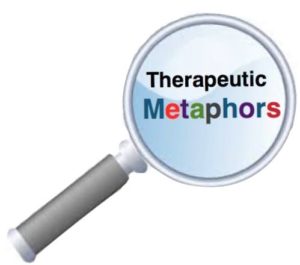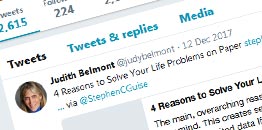
 Original article on pro.psychcentral.com
Original article on pro.psychcentral.com
Did you ever use a rubber band with clients to make a point? A magnifying glass? How about a carnival toy finger trap … or a visualization of monsters on a bus?
Each of these can serve as an example of therapeutic metaphors. Metaphors reach us in a way that unlocks insight and makes complex topics easy for our clients to understand. Metaphors use visualization plus words to reveal emotion and insight. Even the most resistant or confused client appreciates the relevance of a well-chosen metaphor. Using metaphors as a therapeutic tool generates many “aha” moments, and the more metaphors we have at our fingertips, the more potential we have to get our clients “unstuck” and on the path to growth and healing.
Metaphors encourage flexible thinking, and thinking in new ways is a key to resiliency, as we help our clients change old habits and “get out of their own way.”
Here is a small sample of some metaphorical items that I like to use with my clients to demonstrate therapeutic points:
Elastic/Rubber Band: Don’t let yourself get stretched too thin – say “no” without feeling guilty and set limits. Also, elastic is like stress – we need some stress in our lives to feel vibrant, otherwise like a limp rubber band, we will feel disengaged. But don’t stretch too much or you’ll snap!
Crayon: Put color into your world – if you see things in black-and-white you will think in extreme and unhealthy ways.
Eraser: It’s okay to make mistakes – that’s why we have erasers. You don’t have to be perfect!
Magnifying Glass: Identify your cognitive distortions – Be a “thought detective!” Also – Don’t magnify or minimize your issues.
Hershey Kisses: Spread the love! Remind yourself that kindness is more important than being right. Keeping Hershey kisses on hand might help prevent many arguments!
Using metaphorical objects can provide the basis of a great group activity and can also be used with individual clients – I even use metaphorical toolkits in my mental health training and workplace wellness presentations. Having a bag of metaphors that individuals can take away from the session will help reinforce important concepts long after the group experience.
Metaphors also come in the form of visualizations. Acceptance and Commitment Therapy (ACT) uses visualizations liberally to make important therapeutic points. Steven Hayes, founder of ACT, uses the metaphoric visualization of quicksand to make the point that the more we fight our reality and refuse to accept what we can not change, we sink deeper in the quicksand. Only by lying spread-eagle in the quicksand does one stop sinking. Likewise, surrendering to the inevitability of pain and struggle will help us “stay afloat” and not sink!
Another popular metaphor Steven Hayes uses is the metaphor of “monsters on the bus.” He uses the image of an individual being the driver of a bus headed towards a personal goal and being distracted by monsters telling the driver to go off course. The monsters represent our negative and critical thoughts that distract us from reaching our goals.
This handout provides more examples of ACT metaphors to use with your clients.
In closing, keep in mind that we use metaphors all the time and often don’t realize how much we use them to make points. So help your clients stop “painting themselves into a corner” and help them “cross that bridge” to a better life with the help of using metaphors in everyday life!



